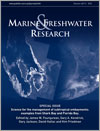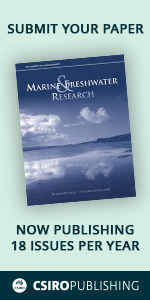Marine and Freshwater Research
Volume 63
Number 11 2012
Science for the Management of Subtropical Embayments: Examples from Shark Bay and Florida Bay
This paper summarises past individual research outcomes from Florida Bay and Shark Bay and introduces the recent research presented in this special issue on ‘Science for the management of subtropical embayments: examples from Shark Bay and Florida Bay’ resulting in a discussion of gaps in our scientific knowledge base for both Florida Bay and Shark Bay.
Excessive evaporation of water from estuaries can cause them to become saltier than the coastal ocean. Natural tracers of water molecules were used to determine the relative amounts of water inputs and outputs for two subtropical bays (Florida Bay and Shark Bay). Understanding the water balance in hypersaline estuaries is important for understanding estuarine health and for effective environmental stewardship.
The preservation of the carbon and nutrient stores in seagrass meadows may be an important mitigation strategy for eutrophication and climate change policy. Assessments in Shark Bay and Florida Bay show that changes in carbon and phosphorus storage have occurred in these systems over the last few millennia. Present-day stocks in Shark and Florida Bay seagrass meadows are comparable to those of terrestrial forests.
In Shark Bay, World Heritage Area, seagrass habitat has been degraded. To inform scientists and managers about strategies used in revegetation and the variability of success, we take a ‘lessons learnt’ approach from analogous systems. No discrete approach could be used with confidence to proceed with a large-scale revegetation program, particularly in Shark Bay. We make recommendations towards improving our understanding of seagrass revegetation and developing cost-effective, proven and scalable technology, rather than implementation of approaches that lack scientific rigour.
The world’s finest examples of modern microbial mats, stromatolites and other microbialites are arranged in three zones that broadly parallel the coastline of Hamelin Pool, Shark Bay. Analysis shows that a seasonal cycle and not the astronomical tide is the most important factor affecting the immersion and exposure of these zones. The microbialite-forming colloform mats are virtually never exposed; however, the most frequently illustrated microbialites are intermittently exposed forms that have been stranded by the falling sea level.
Many submerged aquatic vegetation communities (SAV) have declined because of human activities, and restoring these communities is a common goal. Relationships in the coastal Florida Everglades suggest that light and salinity are both important drivers of SAV abundance, but the importance of these factors varies across the region. It is important to recognise such spatial variability when managing subtropical embayments.
Phosphorus availability influences the ecology of seagrass communities, and mediates key ecosystem functions. We determined the availability of P to seagrasses across the eastern embayment of Shark Bay, and found high local-scale (<10 km) variability. The availability of P to seagrasses in Shark Bay is a complex function of inputs and cycling rates, and will require fine-scale management responses in the face of anticipated changes in phosphorus delivery.
Hydrogen sulfide, ‘rotten egg gas’, is toxic to plants and animals but occurs in quite high concentrations in marine sediments. We examined differences in the intrusion of this gas into the tissues of six seagrasses in Shark Bay and how they might be adapted to survive and flourish with a potentially poisonous gas diffusing into their tissues.
In order to effectively manage, or restore, coastal ecosystems it is critical to understand the potential ecological consequences of declines in top predators. For fifteen years, the Shark Bay Ecosystem Research Project has investigated the role of tiger sharks in a relatively pristine seagrass ecosystem. Here, we review previous work that demonstrates widespread impacts of tiger shark predation risk on a diversity of prey species and suggest that declines of top marine predators may have greater consequences than generally appreciated.
Understanding the food choice of herbivores is important for predicting the potential impacts of changes in their abundance. We investigated seagrass species preference by herbivores in Shark Bay, Western Australia, and found that grazers prefer fast-growing seagrass species with low C : N and C : P ratios. Seagrass communities are important coastal ecosystems that provide high primary productivity and important habitat for many fish and invertebrate species, understanding herbivore feeding preference can provide information necessary for effective management of coastal seagrass communities.
Robust information on dolphin population demographics is critical for the conservation management of the Shark Bay World Heritage Area. We estimated abundance, apparent survival and temporary emigration rates of bottlenose dolphins off Useless Loop in the western gulf of Shark Bay. Abundance estimates varied among years reflecting how individuals use the study area. Our estimates provide a baseline for future comparisons of dolphin demographics in the area.
Animals can reorder their behaviours to better detect predators. We found that dugongs at risk from tiger sharks alternated more often between foraging, during which they could not watch for sharks, and travelling, during which they could be more vigilant. By implication, dugongs fear sharks and reshuffle their behavioural states to maintain a more consistent level of wariness when threatened.
Knowledge of mesopredator movements is important to understanding ecosystem dynamics because mesopredators provide the link between upper and lower trophic levels. Using acoustic telemetry, we found that the most common species of Shark Bay’s ray community use shallow sandflats, especially neashore microhabitats, throughout the day and year-round. The continuous use and limited movements of this ray community suggest these mesopredators have the potential to be a structuring force in this system.
The relative importance of the primary producers that structure seagrass-dominated ecosystems remains unclear. We used fatty acids and stable isotopes to assess the contributions of food sources to consumers and determined that although mixed inputs are important, detrital seagrass supports most fish species. Because Shark Bay is characterised by limited anthropogenic influences, this study provides a baseline for comparison to more impacted seagrass systems.
This is the first study to characterise dissolved organic matter (DOM) in Shark Bay, a low latitude, seagrass-dominated coastal bay. Our results combining isotopic analysis and optical properties suggest that DOM is derived from a mixed source but dominated by detrital seagrass. Climate change, expected to increase terrestrial run-off of DOC, may significantly alter DOM quality in coastal lagoons.
To protect endangered loggerhead sea turtles, it is vital to understand their movements. Using satellite telemetry, we found that tracked male turtles remained within the Shark Bay World Heritage Area and used small coastal foraging areas. Identifying the relevant area, or spatial scale, used by a species is an important element in designing effective conservation strategies and marine protected areas.
Marine managers seek strategies to reduce recreational impacts on sensitive benthic habitats and improve ecological integrity. Analyses of damages to seagrass beds in Florida Bay, Everglades National Park, indicate substantial impacts to seagrass beds and identify factors associated with high densities of damage. Marine managers can utilise factors correlated with damaged areas to develop strategies to protect marine resources and maintain public access.
Sustainability of the recreational fisheries within the Shark Bay World Heritage Area is crucial if its biodiversity is to be maintained. Recreational fishing surveys demonstrated that, between 1998 and 2010, recreational catches of pink snapper (Pagrus auratus) in this region were successfully reduced allowing population recovery. Such ongoing monitoring of recreational fishing activity is essential for effective fisheries management.
Codend mesh shape and size were examined for the Shark Bay scallop trawl fishery to determine if the selectivity of scallops and by‐catch retention could be improved by converting from a diamond to a square-mesh codend. The performance of a 60‐mm square‐mesh codend was able to deliver significant results with up to 30% reduction in undersized scallops and >90% reduction in by-catch, which provides a good basis for commercial application.
Statistical methods used in the mining industry to estimate mineral abundance were applied to describe scallop distributions and how fishers behave when catching them. Comparisons of commercial catch patterns indicated that high survey-abundance areas correlate well with higher catches. The spatial analysis of survey results can thus provide a useful tool for fisheries management.
The Shark Bay Crab Fishery has expanded rapidly to become Australia’s highest-producing blue swimmer crab fishery. However, there is conflicting evidence on the impact of significant increases in catch and effort in this data-limited fishery. This paper documents the history of the fishery, presents the basic biology of the Shark Bay crab stock, outlines a current recruitment decline, and highlights key future research and management issues.
Shark Bay's gulfs have been famous in recreational fishing circles for their snapper fishing for decades. Following overfishing during the 1970s and 1980s, and eventual stock collapse in the 1990s, more than 15 years of research and management action has seen the recovery of local snapper stocks. The Shark Bay snapper story shows that vulnerable marine fish stocks and recreational fisheries can be sustainably managed in areas of high conservation value.
The mainly recreational snapper fishery within Shark Bay is managed on a fine spatial scale (tens of kilometres). A tagging study with ~700 recaptures show snapper movement is highly restricted and supports the current use of 3 small fishery management zones. Community understanding and acceptance of these complex arrangements was aided by collaborating with volunteer stakeholders in tagging and other research programs.




